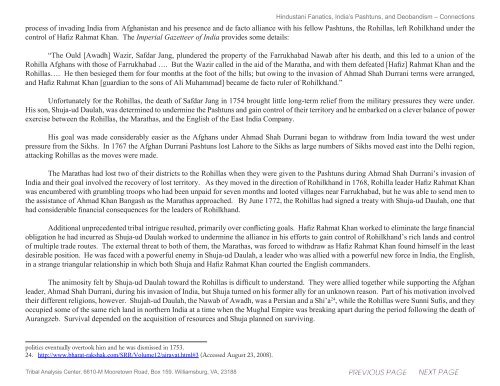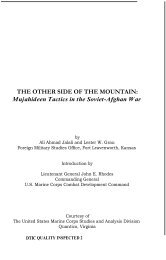Hindustani Fanatics, India’s Pashtuns, <strong>and</strong> Deob<strong>and</strong>ism – ConnectionsBut Ali Muhammad <strong>and</strong> the other Rohilla leaders were more than just military leaders. They also remained in contact with the region that istoday’s Afghanistan through profitable horse-trading along developed, protected trading routes while also building a solid agricultural base for theireconomy in northern India. Both are important factors that made them relatively wealthy, but this new wealth also attracted powerful enemies.“… most Afghan states were formed along horse-trading routes, … the formation of the Rohilla state in Rohilkh<strong>and</strong> vividly illustrates the themeof horse trader turned state builder. Using money embezzled from his own adopted father, one of the founders of the Rohilla state, Da’ud Khan,bought horses at north Indian fairs <strong>and</strong> then launched a dazzling career as highwayman, revenue farmer, cavalry officer, <strong>and</strong> local l<strong>and</strong>owner, allwhile recruiting other Afghans who migrated to Rohilkh<strong>and</strong> with their horses. By the 1730’s his adopted son, Ali Mohammad, had carved outan effective state, styling himself nawab, <strong>and</strong> was acknowledged as such by the Mughal emperor. But the Rohilla phenomenon was no “tribalbreakout.” In addition to fostering in Rohilkh<strong>and</strong>, a semipastoral economy sustained by close ties with horse markets in Afghanistan, the Rohillasalso promoted deforestation in the territories they controlled, dug wells <strong>and</strong> canals, <strong>and</strong> generally promoted l<strong>and</strong> reclamation <strong>and</strong> agrarian wealth. 19 ”According to Safia Haleem’s Study of the Pathan Communities in Four States of India, the Rohillas that settled in Katehr, once they suitablyconquered it, were immigrants <strong>and</strong> descendents of the M<strong>and</strong>ar Yusufzai Pashtuns, one of probably several migrant Pashtun tribes that entered India,especially in the seventeenth <strong>and</strong> eighteenth centuries. The region under their control was reported to be very fertile <strong>and</strong> composed of well-aeratedloam soil that was easily cultivated. But in addition to its fertile l<strong>and</strong>, Rohilkh<strong>and</strong> was a key trade crossroads with intersecting routes coming fromseveral directions. For example:“During 18 th Century the eastern track [of the Gr<strong>and</strong> Trunk Road] shifted northwards entering Rohilkh<strong>and</strong> via central Awadh [also knownas Ould <strong>and</strong> Oudh in the literature] <strong>and</strong> Farrukhabad. From there traffic could bypass Delhi altogether <strong>and</strong> continue either south to Jaipur <strong>and</strong> otherRajput cities or through Bareily, along the hills via Najibabad. The route circumvented the Punjab <strong>and</strong> Delhi <strong>and</strong> caravans could reach Peshawar <strong>and</strong>Kabul without touching Sikh territory. 20 ”“Hafiz Rahmat Khan, guardian to his sons [of Ali Mumammad], succeeded to the governorship of Rohilkh<strong>and</strong>….” 21 And he was also involvedin the horse trade, moved to Rohilkh<strong>and</strong> around 1730. He used to purchase horses from the north of present day Afghanistan disposed them off inDelhi while going to his new home in Aonla 22 .”Wealth <strong>and</strong> the promise of additional prosperity to come from both trade <strong>and</strong> agriculture made a target out of the Rohilla tribal l<strong>and</strong>s in India.One of the most powerful men in Dehli’s court soon moved against the region once controlled by the Bangash Pashtuns, Farrukhabad, <strong>and</strong> SafdarJang 23 sought to exp<strong>and</strong> his control outward from Delhi. Fortunately for the Rohillas, another Pashtun leader, Ahmad Shah Durrani, was in the19. Eaton, Richard M., The Journal of Asian Studies, Vol. 56, No.2 (May, 1997), pp. 518-520. This is a review of Jos J. Gomman’s Rise of the Indo-Afghan Empire c. 1710-1780.20. See Safia Haleem’s “Study of the Pathan Communities in Four States of India at http://www.dawatnet.com/full2.php?id=334, accessed August 13, 2008.21. Hunter, William Wilson, Imperial Gazatteer of India, Vol. 7. pp. 3-5.22. Aonla is a city located in Bareilly district of Uttar Pradesh.23. From Wikipedia: Safdar Jang, popularly known as Safdarjung (1708-5 October 1754) was the second Nawab of Awadh, of the Awadh dynasty. Safdarjung was an ableadministrator. He was not only effective in keeping control of Awadh, but also managed to render valuable assistance to the weakened Muhammad Shah. He was soon givengovernorship of Kashmir as well, <strong>and</strong> became a central figure at the Delhi court. During the later years of Muhammad Shah, he gained complete control of administration in theMughal Empire. When Ahmad Shah Bahadur ascended the throne at Delhi, Safdarjung became his Wazir ul-Mamalik-i-Hindustan or Chief Minister of India. However, courtTribal Analysis Center, 6610-M Mooretown Road, Box 159. Williamsburg, VA, 23188
Hindustani Fanatics, India’s Pashtuns, <strong>and</strong> Deob<strong>and</strong>ism – Connectionsprocess of invading India from Afghanistan <strong>and</strong> his presence <strong>and</strong> de facto alliance with his fellow Pashtuns, the Rohillas, left Rohilkh<strong>and</strong> under thecontrol of Hafiz Rahmat Khan. The Imperial Gazetteer of India provides some details:“The Ould [Awadh] Wazir, Safdar Jang, plundered the property of the Farrukhabad Nawab after his death, <strong>and</strong> this led to a union of theRohilla Afghans with those of Farrukhabad …. But the Wazir called in the aid of the Maratha, <strong>and</strong> with them defeated [Hafiz] Rahmat Khan <strong>and</strong> theRohillas…. He then besieged them for four months at the foot of the hills; but owing to the invasion of Ahmad Shah Durrani terms were arranged,<strong>and</strong> Hafiz Rahmat Khan [guardian to the sons of Ali Muhammad] became de facto ruler of Rohilkh<strong>and</strong>.”Unfortunately for the Rohillas, the death of Safdar Jang in 1754 brought little long-term relief from the military pressures they were under.His son, Shuja-ud Daulah, was determined to undermine the Pashtuns <strong>and</strong> gain control of their territory <strong>and</strong> he embarked on a clever balance of powerexercise between the Rohillas, the Marathas, <strong>and</strong> the English of the East India Company.His goal was made considerably easier as the Afghans under Ahmad Shah Durrani began to withdraw from India toward the west underpressure from the Sikhs. In 1767 the Afghan Durrani Pashtuns lost Lahore to the Sikhs as large numbers of Sikhs moved east into the Delhi region,attacking Rohillas as the moves were made.The Marathas had lost two of their districts to the Rohillas when they were given to the Pashtuns during Ahmad Shah Durrani’s invasion ofIndia <strong>and</strong> their goal involved the recovery of lost territory. As they moved in the direction of Rohilkh<strong>and</strong> in 1768, Rohilla leader Hafiz Rahmat Khanwas encumbered with grumbling troops who had been unpaid for seven months <strong>and</strong> looted villages near Farrukhabad, but he was able to send men tothe assistance of Ahmad Khan Bangash as the Marathas approached. By June 1772, the Rohillas had signed a treaty with Shuja-ud Daulah, one thathad considerable financial consequences for the leaders of Rohilkh<strong>and</strong>.Additional unprecedented tribal intrigue resulted, primarily over conflicting goals. Hafiz Rahmat Khan worked to eliminate the large financialobligation he had incurred as Shuja-ud Daulah worked to undermine the alliance in his efforts to gain control of Rohilkh<strong>and</strong>’s rich l<strong>and</strong>s <strong>and</strong> controlof multiple trade routes. The external threat to both of them, the Marathas, was forced to withdraw as Hafiz Rahmat Khan found himself in the leastdesirable position. He was faced with a powerful enemy in Shuja-ud Daulah, a leader who was allied with a powerful new force in India, the English,in a strange triangular relationship in which both Shuja <strong>and</strong> Hafiz Rahmat Khan courted the English comm<strong>and</strong>ers.The animosity felt by Shuja-ud Daulah toward the Rohillas is difficult to underst<strong>and</strong>. They were allied together while supporting the Afghanleader, Ahmad Shah Durrani, during his invasion of India, but Shuja turned on his former ally for an unknown reason. Part of his motivation involvedtheir different religions, however. Shujah-ud Daulah, the Nawab of Awadh, was a Persian <strong>and</strong> a Shi’a 24 , while the Rohillas were Sunni Sufis, <strong>and</strong> theyoccupied some of the same rich l<strong>and</strong> in northern India at a time when the Mughal Empire was breaking apart during the period following the death ofAurangzeb. Survival depended on the acquisition of resources <strong>and</strong> Shuja planned on surviving.politics eventually overtook him <strong>and</strong> he was dismissed in 1753.24. http://www.bharat-rakshak.com/SRR/Volume12/airavat.html#3 (Accessed August 23, 2008).Tribal Analysis Center, 6610-M Mooretown Road, Box 159. Williamsburg, VA, 23188
- Page 7: Hindustani Fanatics, India’s Pash
- Page 11 and 12: Hindustani Fanatics, India’s Pash
- Page 13 and 14: Hindustani Fanatics, India’s Pash
- Page 15 and 16: And Charles Allen described the sce
- Page 17 and 18: Hindustani Fanatics, India’s Pash
- Page 19 and 20: Charles Allen provided additional d
- Page 21 and 22: Hindustani Fanatics, India’s Pash
- Page 23 and 24: Hindustani Fanatics, India’s Pash
- Page 25 and 26: Hindustani Fanatics, India’s Pash
- Page 27 and 28: Hindustani Fanatics, India’s Pash
- Page 29 and 30: that Shah Waliullah’s ancestors w
- Page 32: Hindustani Fanatics, India’s Pash
- Page 35 and 36: Hindustani Fanatics, India’s Pash
- Page 37 and 38: Hindustani Fanatics, India’s Pash
- Page 39: Hindustani Fanatics, India’s Pash
- Page 42 and 43: Hindustani Fanatics, India’s Pash
- Page 44 and 45: Hindustani Fanatics, India’s Pash
- Page 46 and 47: Hindustani Fanatics, India’s Pash
- Page 48 and 49: Hindustani Fanatics, India’s Pash
- Page 50 and 51: Hindustani Fanatics, India’s Pash
- Page 52 and 53: Hindustani Fanatics, India’s Pash
- Page 54 and 55: Hindustani Fanatics, India’s Pash
















